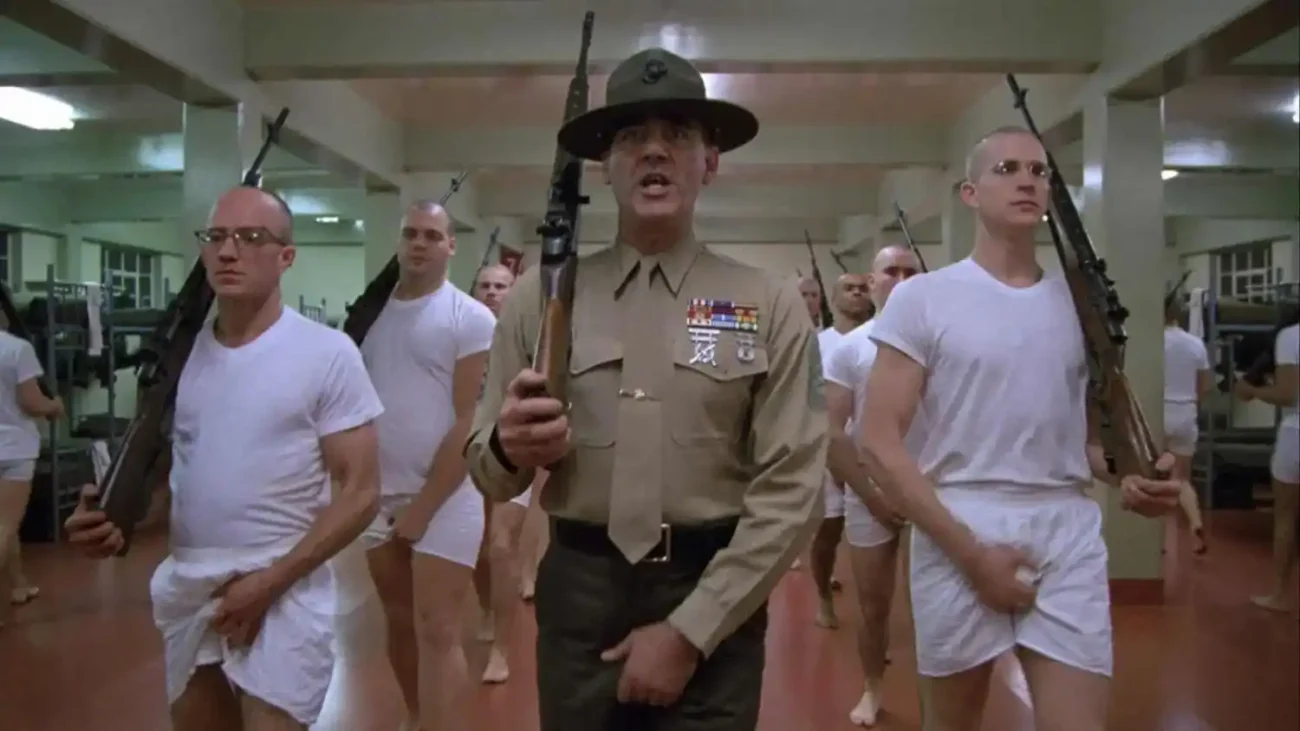- Full Metal Jacket is Rated R by Motion Picture Rating (MPA) for violence, language, and sexual content.
- On Common Sense Media, it’s rated for age 17+ given its intense content.
- This film is most appropriate for mature teens (16-17+) and adults. Given its rating and heavy content, I would not recommend it for younger teens or children.
Movie – Summary & Overview
When I settle in to watch Full Metal Jacket, I’m struck anew by how Stanley Kubrick splits this film into two very different but thematically linked acts. Released in 1987, directed by Kubrick himself (with co-writing from Michael Herr and Gustav Hasford), this war drama stars Matthew Modine as Joker, Vincent D’Onofrio as the troubled Pyle, and the unforgettable R. Lee Ermey as Gunnery Sergeant Hartman.
Set first in Marine boot camp at Parris Island and then in Vietnam during the Tet Offensive, the film carries you from head-shaving drills and shouted commands to chaotic firefights and moral ambiguity. Kubrick doesn’t offer comforting closure he holds up a mirror to what war does to people.
What I like about Full Metal Jacket is that it rewards deep thought. It’s not an escapist war flick; it’s a probe into how systems shape people, and how war stretches the lines between duty and destruction. That said, I’d never recommend it casually to families with younger kids.
If I were recommending an age, it’s best suited to older teens (16 or 17 and up) and adults. As a parent or guardian, I’d warn that some of the scenes (particularly the suicide and battlefield aftermath) might linger in your mind and upset more sensitive viewers.
Full Metal Jacket is a tough, uncompromising film that doesn’t cater to comfort. For viewers prepared for its weight and for families ready to have honest conversations afterward it offers insight not just into war, but into the human cost of following orders. But it’s not a film to watch lightly, and not appropriate for kids or relaxed movie nights.
Detailed Content Breakdown for Parents
Violence & Intensity: This film is intense. There is military combat (gunfire, explosions, sniper attacks), soldiers dying (some in graphic detail), and wounded. The boot camp portion includes psychological abuse, harsh punishments, and at one point a recruit uses a firearm on himself (a suicide scene is shown with graphic effect). The war sequences are not sanitized they convey chaos, fear, and brutality.
Because of this, some scenes may be deeply disturbing to younger or sensitive viewers.
Language: The use of profanity is pervasive pretty much all the “strong” expletives appear multiple times. The drill sergeant uses racial slurs (e.g. referring to African Americans, Italians, Jews) and homophobic insults in belittling recruits. There is also demeaning language directed at Vietnamese characters (common in war films of this era).
Sexual Content / Nudity: Sexual content is limited but present. A Vietnamese prostitute propositions American servicemen, negotiating payment for sexual acts her dialogue includes suggestive language “me so horny,” etc.
There is no full nudity, but the interactions are clearly sexual in theme.
Drugs, Alcohol & Smoking: Cigarette smoking is shown among some soldiers. There is no strong emphasis on drug use, though war films often imply stress and coping mechanisms. Alcohol is not a major focus, though small scenes or mentions may occur.
Scary or Disturbing Scenes: Yes, several. The suicide and gun violence in boot camp are psychologically jarring. The war zone scenes include wounded, destruction, corpses, and ambiguous, traumatic conflict. Some scenes evoke a sense of dread and chaos more than explicit gore, but the cumulative effect is emotionally heavy.
Positive Messages / Role Models
The film doesn’t offer many “clean” heroes, but Joker functions as a somewhat moral center — someone trying to maintain a questioning perspective amid the madness. The movie challenges notions of identity, the cost of obedience, and how individuals respond to brutal systems. It suggests that empathy and self-awareness matter even in harsh circumstances.
Diversity / Inclusion Themes: Because the film is about U.S. Marines in Vietnam, we see a racially diverse group of recruits. The language and treatment highlight prejudice and how authority may weaponize biases. The film indirectly prompts viewers to reflect on how uniformity, dehumanization, and hierarchy suppress individuality.
Parental Concerns
- The graphic intensity may shock kids or teens not prepared.
- The language is extremely strong and unfiltered for most of the film.
- The suicide and self-harm scene is emotionally disturbing.
- The film’s moral ambiguity means it doesn’t wrap up with clear “good vs. evil” messages some might find it nihilistic.
- Younger viewers might have trouble with thematic depth or be troubled by the bleakness.
Summary
Full Metal Jacket is a powerful, often unsettling war drama that delivers a sharp critique of dehumanization, military indoctrination, and the psychological cost of combat. Because of its explicit violence, strong language, and emotional weight, it’s not suitable for children or casual family viewing. But for older teens or adult moviegoers interested in war cinema, psychological depth, and morally challenging storytelling with parental forewarning it can spark meaningful conversations about war, authority, and humanity.
Director: Stanley Kubrick
Writers: Stanley Kubrick, Michael Herr, and Gustav Hasford
Stars: Matthew Modine, R. Lee Ermey, and Vincent D’Onofrio
Release date: July 10, 1987 (United States)
Countries of origin: United Kingdom, and United States
Languages: English, and Vietnamese
